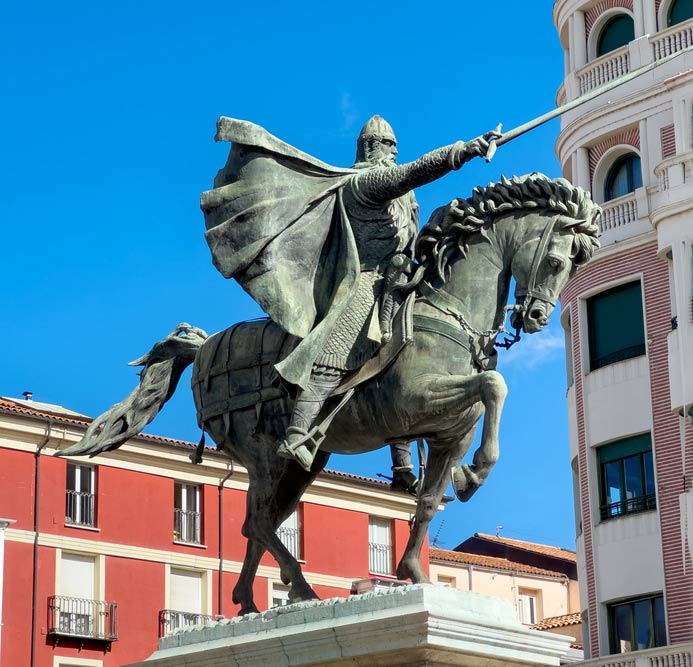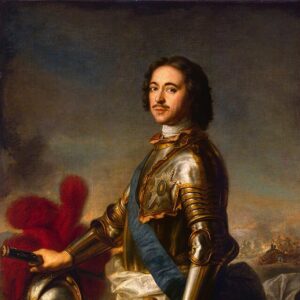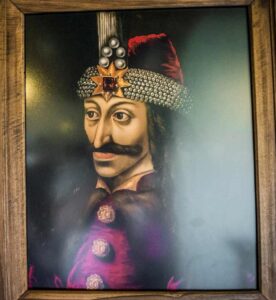In the eleventh century Rodrigo Díaz de Vivar (c. 1043–1099) emerged during the breakup of the Caliphate of Córdoba (1031) into competing taifas and the rise of rival Christian kingdoms (León-Castile, Aragon, Navarre, Barcelona).
Trained as a noble household officer, he became alférez (standard-bearer) to Sancho II of Castile, shifted to Alfonso VI after 1072, and was exiled in 1081, after which he served the Taifa of Zaragoza as a professional commander, defeating coalitions that included Aragon and Barcelona (Almenar 1082; Tévar 1090).
Following Toledo’s Christian conquest (1085) and the Almoravidintervention (1086), Rodrigo moved to the Levant, seized Valencia in 1094, and repelled an Almoravid relief army at Cuarte the same year, ruling Valencia until his death in 1099; his widow Jimena held the city until its evacuation in 1102.
Later literature, especially the Poema de mio Cid (early 13th century), consolidated his reputation as El Cid(from the Arabic al-Sayyid, “the lord”) and “Campeador(“master of the battlefield”),” turning a documented career—court officer, mercenary captain, city-founder—into a central case study in the politics and warfare of the Reconquista.
This is the story told in a straight line: the Iberia he walked into, the boy he was, the captain and founder he became, why Valencia mattered, how he died, what came apart afterward, and what—despite everything—never did.
Before El Cid of Spain: Iberia After the Caliphate
A century before Rodrigo was born, al-Andalus—Muslim-ruled Iberia—was held together by the Caliphate of Córdoba, a state as polished and wealthy as any in the Mediterranean. Then, in the early 1000s, the caliphate fractured in a civil storm known as the fitna. Out of the wreckage came dozens of taifas—city-states like Seville, Toledo, Zaragoza, Valencia, Badajoz, each with its own court, treasury, and army, each jealous of the others.
These taifas were literate, trading, culturally bright—and vulnerable. They paid parias (tribute) northward to buy peace. They hired Christian and Muslim mercenaries. They schemed because they had to.
North of the old caliphate, the Christian kingdoms formed a mosaic just as checkered: León, Castile, Navarre, Aragon, and the Catalan counties (especially Barcelona). They competed with one another as often as they pushed south.
Borders were porous; allegiance could be a season-long contract; kinship and cash twisted around faith without replacing it. This is not cynicism; it is the daily arithmetic of life where every neighbor is both a threat and a future ally.
Two big shifts framed Rodrigo’s career. First, the Christian north grew more professional. Kings like Ferdinand I and his son Alfonso VI organized royal mesnadas (household troops), tightened control over revenues, and rewarded leaders who could march on time and pay their men.
Second, across the Strait of Gibraltar, a disciplined reform movement hardened into a state: the Almoravids. In 1086 they would land in Iberia to “correct” what they saw as Muslim laxity and to challenge Christian expansion.
This is the weather Rodrigo Díaz inherited: fractured, cash-rich, opportunity-soaked, and ruthless. The sort of place where a man with judgment and nerve could build something real—if he could keep it.
A Boy from Vivar: Learning the Grammar of Power
Rodrigo was likely born around 1043 in Vivar, a village near Burgos in the heart of Castile. His father, Diego Laínez, belonged to the lower stratum of the high nobility: land to oversee, men to arm, and the expectation of mounted service to the king.
Rodrigo grew up in a household where horseflesh mattered as much as bookhands, where the sound of prayers in a small chapel blended with the crack and thud of practice lances.
His education was practical. He learned to ride young, to take a lance clean, to swing sword and mace, to dismount and fight on foot (a habit the Christian north increasingly prized). He learned the language of charters and oaths, how to read faces in council as if they were a different kind of battlefield, how to add columns in a world where the king’s coin and a church tithe could turn a raid into a campaign or a campaign into a winter famine.
In the late 1050s and early 1060s, Rodrigo drifted toward the orbit of Sancho, eldest son of Ferdinand I. When Ferdinand died in 1065, he carved his realm among his children—Sancho took Castile, Alfonso took León, García took Galicia, and their sisters received cities and incomes.
Like most partitions, this one was a promise of trouble. Rodrigo, by then a trusted fighting man in Sancho’s household, rose to the post of alférez—standard-bearer to the king, a role that mixed battlefield proximity with day-to-day logistical command. The alférez drilled the royal mesnada, set the pace on the march, and, in a crisis, stood close enough to the king to push or pull him when necessary.
He also married Jimena Díaz (Ximena), probably in the mid-1070s, aligning himself with a family network that ran through León and Asturias. In that world, marriage was affection wrapped around architecture—alliances, dowries, fallback fortresses.
From Sancho to Alfonso: A Narrow Bridge Over a Pit
Sancho aimed to re-stitch his father’s kingdom into one cloth; Alfonso and García resisted. In 1072, during the siege of Zamora, a Leonese stronghold held by their sister Urraca, Sancho was assassinated by a Zamoran knight. In a single night the board flipped.
Alfonso, returning from exile, took León and Castile, and the man who had been Sancho’s backbone had to learn a new skill: how to be useful to a king who had reason to distrust him.
Legend fills the gap with the oath of Santa Gadea, in which Rodrigo supposedly forced Alfonso to swear publicly that he had not arranged Sancho’s murder. Whether that scene happened as told, the tension it captures is real. Alfonso needed Sancho’s best captain. The captain was a daily reminder of Sancho. The new arrangement was workable and brittle.
It snapped in 1081. Causes differ in the telling. One version says Rodrigo led an unauthorized raid into lands protected by Toledo, a taifa paying parias to Alfonso; another blames politics and jealousy at court. Whatever the trigger, the sentence was the same: exile.
Rodrigo gathered his household knights, their squires, their families, and the thread of tradesmen and camp followers that always trails an army that pays, and he went east in search of a contract.
He found one in Zaragoza.
The Zaragoza Years: A Christian Captain Under a Muslim Banner
The Banu Hud dynasty that ruled the Taifa of Zaragoza—first al-Mu’tamin, then al-Musta‘in II—hired Rodrigo as their chief military commander. Between 1081 and 1086, his mesnada became the core of Zaragoza’s army, and he fought for his Muslim employers against whichever enemy threatened them—most often Aragon and Barcelona, both Christian.
If that jars the modern ear trained on clean religious lines, it shouldn’t. This was the frontier’s real logic: oath, pay, and opportunity, inside a cosmos where faith mattered but did not erase yesterday’s contract.
Two victories put Rodrigo’s name in other men’s mouths far from the Ebro. At Almenar (near Lleida, commonly dated 1082), he defeated a coalition and captured the Count of Barcelona, Berenguer Ramón II. Near Morella, on another field, he beat the Aragonese.
Later, in 1090, at Tévar, he would capture the Barcelona count again, a humiliation that traveled like smoke and stuck like pitch. Ransoms fattened his war chest. Tributes from worried neighbors kept his company fed. His method began to show: march hard but not to panic, choose ground that multiplies the long spear and the short bow, exhaust the other man’s nerve and horses, then hit the hinge.
Meanwhile, the wider sky darkened and then split. In 1085, Alfonso VI took Toledo, the old Visigothic capital, an act that rang across Islam and Christendom. Taifa rulers, unsteady and afraid, called for help across the Strait. In 1086, the Almoravids landed.
At Sagrajas (Zallaqa), they beat Alfonso badly. They were neither raiders nor tourists; they were a disciplined, state-building force intent on refashioning the peninsula’s politics. Alfonso needed a grown-up immune to delusion—a man who had watched Almoravid style from close range and could build a defense quickly. He recalled Rodrigo.
Valencia: From Freelancer to Founder
Rodrigo did not simply return to court and become a salaried spear. He looked east to the Levante, where Valencia sat—a jeweled city with a complicated elite, wealthy markets, irrigated horta (farmland) that could feed an army and a treasury, and a hinterland that could be coaxed or crushed.
Between 1086 and 1094, he executed a campaign of pressure—a long, dry siege stretched over years: raids that took supplies, negotiations that took promise notes, the installment and dismissal of local power brokers, tributary agreements that kept money flowing from Valencia without snapping its economy. He was teaching a city to accept him as weather.
In 1092, Valencia’s fragile balance shattered. A faction hostile to Rodrigo killed the qadi (judge) who had favored him and declared for the Almoravids. Rodrigo returned, not with fury but with engineering. He blockaded the roads, burned carefully where burning mattered, held the countryside, and let hunger perform what ladders and blood would not. In June 1094, Valencia opened. An exile from Sancho’s court now held a Mediterranean city in his own name.
Weeks later, an Almoravid relief army arrived to test the new arrangement. Rodrigo marched out of Valencia’s gates and beat them at the Battle of Cuarte. The news traveled as news like this does: in the anxious breathing of coastal towns, in letters to Italian merchants, in sermons with points sharpened for the coming decade. A Christian lord had taken a great Muslim city and held it against North Africa’s best.
The four years after Cuarte were the most creative of Rodrigo’s life. He set about turning conquest into government. He minted coins. He channeled taxes without starving trade. He converted the Great Mosque into a cathedral and brought in Jerome of Périgord, a French reform bishop, to head the new diocese; at the same time, he allowed a mixed population—Muslims, Christians, Jews—to keep living and working under predictable rules. He was no modern pluralist; he was a sensible prince. A city is a machine; if you strip the wrong parts, it stops.
He tended symbol, too. Later ballads endowed him with two swords—Tizona and Colada—and a horse, Babieca, who seems to snort across every canvas where artists need him. The historical Rodrigo knew the value of public justice—hear petitions under an awning where everyone can see, reward loyalty, distribute spoils with care, and most of all, pay on time. Valencia’s safety depended as much on confidence as on quarried stone.
In 1097, near Bairén (around modern Gandía), he chose his ground again and defeated another Almoravid force. It didn’t reverse the African tide. It did slow it. Slow is strategy’s secret weapon; you use it to buy time for things that last longer than a day: tax codes, marriage alliances, harvests, and the sense that tomorrow belongs to you.
Why He Mattered for the Reconquista (Beyond the Poster)
In textbooks, the Reconquista can look like a clean arrow of Christian advance sweeping south. Rodrigo’s career adds joints to that arrow, gives it elbows, and makes it human—and in doing so shows why he mattered.
He professionalized conquest. Rodrigo’s mesnada was a career army. He kept it happy with stipends, spoils, and security, and he used it as the core around which local levies could form.
Kings in León and Castile were experimenting with the same idea—less reliance on seasonal feudal musters, more on reliable cores. Rodrigo was the example that proved the budget could buy stability in the field.
He proved a Mediterranean city could be governed, not just taken. The Christian north had spent a century watching taifas run efficient cities. Rodrigo showed that a Christian regime could inherit that machinery, adjust it, and keep it running.
The proof mattered for later conquests—especially when James I of Aragon came down the coast in the thirteenth century. Valencia, in that sense, was both an anachronism (a Christian island ahead of its time) and a prototype.
He blunted the Almoravid correction. After Toledo (1085), the Almoravids were always coming. Rodrigo could not stop an empire. He could complicate it—force it to spend years and men on the Levante—buying time up north for Christian polities to consolidate, tax, and learn. In a long war, time is a form of victory.
He embodied the frontier’s real rules. He fought for Zaragoza against Aragon and Barcelona; he then ruled Valencia against the Almoravids. That is not inconsistency; it is the logic of oaths and opportunities in an age when religion framed life but did not micromanage every Tuesday.
Seeing him clearly helps us see the Reconquista as a process(centuries of pressures and settlements) rather than a pageant.
Decline, Last Acts, and a Death That Undid a City
Victories do not repeal the arithmetic of supply and stamina. After 1097, Almoravid pressure grew patient and heavy around Valencia. They didn’t need to beat Rodrigo in a banner battle; they could wear the city and its lord down: choke lanes, sap allies, keep nerves frayed.
In July 1099, Rodrigo Díaz died in Valencia—almost certainly of natural causes, likely in his mid-fifties. Legend insists that Jimena had his body armored and tied upright on Babieca to ride out one last time and frighten the besiegers. It is a fine story, and like many fine stories it is probably poetry. What it captures, perfectly, is the psychology of the garrison: their courage rode with him.
His widow, Jimena, took command with help from Alfonso VI, who sent troops when he could. She held on—not for weeks, but for years—which is one of those feats that gets less attention than it deserves because it ends with leaving.
In 1102, Alfonso counted lives and wagons and made the decision that always feels like failure but often is mercy. He evacuated the Christian population, ordered parts of the city burned (certainly its fortifications), and abandoned Valencia. The Almoravids entered.
If your measure of success is permanence, that’s the end. If your measure is what gets taught, it’s an intermission. Rodrigo’s Valencia did not survive him by long. Rodrigo’s example—the proof that such a thing could be built—did.
It hung in the air of the peninsula for more than a century, and when kings and counts to the north thought about the coast, they could say, “It is not impossible. It has been done.”
As for Rodrigo himself, tradition says he was first buried at the monastery of San Pedro de Cardeña near Burgos, later moved with Jimena to Burgos Cathedral, where the stone floor remembers the tread of tourists chasing a poem into a church.
Aftermath: The Man Becomes a Story; The Story Becomes a Tool
Once the Almoravids took Valencia, the immediate epilogue was short. The longer one—the memory—is the reason you’re reading this.
By the early thirteenth century, a long poem had gathered around Rodrigo’s life: the “Poema de mío Cid.” It is one of the great survivals of medieval literature—lean, unsentimental, and obsessed in the best way with honor as a technology for making society run.
The poet’s Rodrigo is the perfect vassal—wronged and patient, justified by victory, generous in triumph, deliberate in rage. The poem compresses and polishes. The messy Zaragoza years shrink. The oath at Santa Gadea glows with theatrical certainty. Tizona and Colada become named characters. Babieca becomes as immortal as any man.
If you are looking for a documentary, you have chosen the wrong genre. If you are looking for a manual of how people wanted power to behave—how oaths bind, how marriage binds, how merit should outlast slander—the poem is better than a chronicle. It tells us how the age thought institutions should work, even when they didn’t.
Across the centuries, Rodrigo became a banner for causes he never imagined. In medieval Iberia, he could be the model of the competent lord. In early modern Spain, the emblem of noble duty. In the nineteenth century, when romantic nationalism needed ancestors, the founding hero.
In the twentieth, under a dictatorship hungry for usable myths, the crusading Spaniard. In our century, he is a case study in frontier pragmatism—a reminder that real history is both less clean and more interesting than anyone’s poster.
Meanwhile, archivists and historians keep plumbing the record: charters, letters, Arabic and Latin chronicles, coins stamped under his authority. The historical Rodrigo has edges the poem sands down; the literary Cid has a charisma the documents cannot bottle. The gap between them is not disappointing. It is a productive space where we learn how memory is made.
Legacy: What Survives When the Trumpets Go Silent
Strip the trumpets away and several legacies keep standing.
A working model of frontier lordship. Rodrigo showed how to convert exile into leverage: assemble a professional mesnada; find revenue (ransom, tribute, tax) that does not kill the host; create public rituals of justice that make people believe the new order can keep its own promises; and, when possible, tie it all to a port. His Valencia was more than flags; it was admin, coin, courts, bishop, market—the bones of a state.
The professionalization of Christian warfare. The eleventh century saw Iberian kings shift from seasonal feudal levies toward standing cores of fighters. Rodrigo embodied that shift. He proved that if you keep a company paid and proud, it will win you time—and time is the most expensive commodity in a long war.
Politics inside a religious frame. Rodrigo’s years for Zaragoza and then in Valencia don’t cancel each other; they reveal the actual operating system of the Reconquista: faith at the center, yes, but also contract, kinship, pay, opportunity. Seeing that mix is not relativism. It is respect for how people survive and build.
A meaningful check on a powerful empire. The Almoravids were serious state-builders. Rodrigo forced them to spend years and generals on his corner of the map. He did not stop them; he staggered them. That stagger helped the north adjust to a new equilibrium instead of capsizing.
A cultural grammar of honor. The Poema de mío Cid codified how honor worked in the minds of those who relied on it: what a lord owes a man who keeps an oath; what a man owes a family whose daughter he marries; what public reputation does to private disputes. That grammar long outlived the battlefields. It shaped literature, law, and the way communities measured character.
A caution against easy heroes. Because every century has tried to draft El Cid for its campaign, he serves as a standing reminder: beware straight lines. The man who stabilized a Muslim taifa and later ruled a mostly Muslim city as a Christian lord is a complicated fact. He frustrates propaganda and rewards history.
And yes, relics and symbols cling to the name. A sword called Tizona (almost certainly a re-hilted medieval blade) has been shown and treasured. Babieca eats oats on every canvas that needs him. Burgos and Cardeña divide their claims with a civility late medieval politics sometimes lacked. Valencia embeds his name in its festivals. None of these objects proves anything by itself. They are handles—ways for the present to pick up the past.
The origins of El Cid name
The nickname “El Cid” wasn’t what Rodrigo’s own generation called him; it’s a later label that grew from the Arabic honorific sayyid / sîdī (“lord”), probably passing through Mozarabic speech into Old Castilian as Çid and eventually Cid.
In his lifetime, documents and Latin narratives style him chiefly as Rodericus (Ruy) Díaz and Campeador (from Latin campi doctor, “master of the field”), a title also mirrored in Arabic sources that render him as al-Qanbiyātur (an Arabized “Campeador”).
The earliest written appearance of “Cid” seems to be mid-12th century—Meo Çidi in the Poem of Almería (c. 1147–1149)—with the nickname then popularized a few decades later by the Cantar/Poema de mio Cid; historians have not found contemporary (11th-century) records that call him “Cid.”
A Single, Human Ending
Reduce him one last time to a walk you can picture. A boy in Vivar learns to sit in a saddle and read a charter. A young officer steadies a royal standard in a civil war not of his making. A captain loses his place and follows the paycheck east to a court that prays in Arabic but demands the same results.
A professional becomes a founder, turning a city’s markets into a treasury and a treasury into an army and an army into a border the other side has to think twice about crossing. An empire rises out of the south and he leans against it, choosing ground and waiting until the ground itself helps him fight. He grows older. He wins. He pays. He sets a bishop in a mosque and calls the city by a new name.
Then he dies. His widow—extraordinary and underrated—keeps faith as long as the arithmetic allows. A king arrives who counts lives correctly and orders an evacuation. Fire follows. The other empire enters. The poem begins.
In Burgos Cathedral today, people step softly over a slab that carries Rodrigo and Jimena, then drift to the museum cabinets hoping a sword or a bit of harness will tingle. If you step back outside into the sun and let the city noise drown the tour-guide patter, the lesson is clearer than any label. El Cid did not “complete” the Reconquista; no one person could. He did something rarer and, in some ways, more impressive.
He changed the shape of possibility. He proved that a competent, professional commander could found and govern a Mediterranean city long in the Islamic orbit; that a disciplined method could sometimes outrun numbers; that honor—understood as keeping your word and knowing your price—could be a usable social technology in a messy world. He turned exile into leverage and leverage into a state. The state did not outlive him by much. The example did.
That is legacy enough. Not sainthood. Not a poster. A standard: competence bent to purpose, held long enough to move the ledger of a continent one line in the direction its future would follow. If you want a single sentence to carry away, take the one the poem hints at and the documents confirm: in a century of improvisation, Rodrigo Díaz improvised well enough to be remembered—and to leave behind a map not of what to admire, but of what to do when the ground under your horse is the only thing between order and drift.





